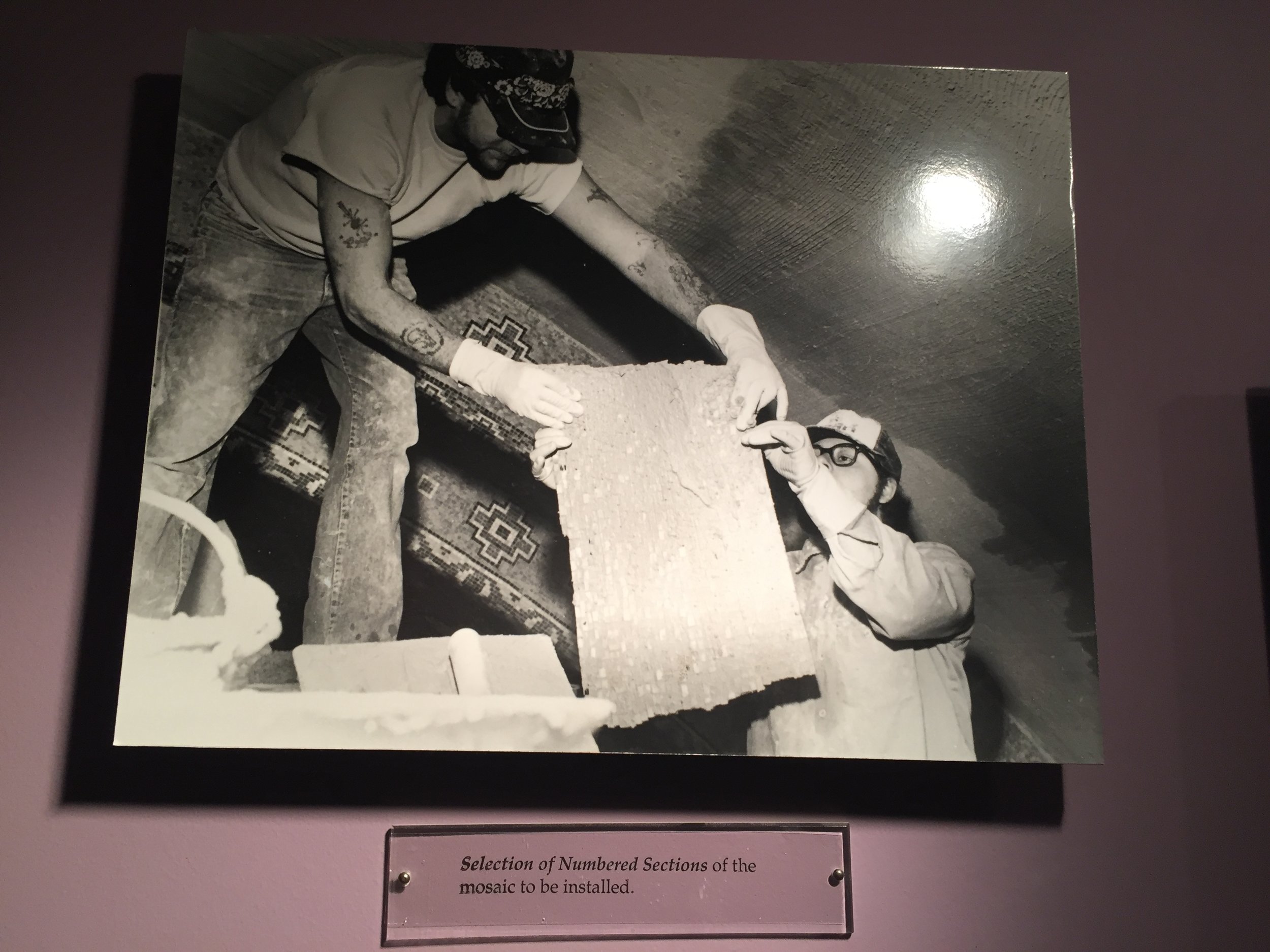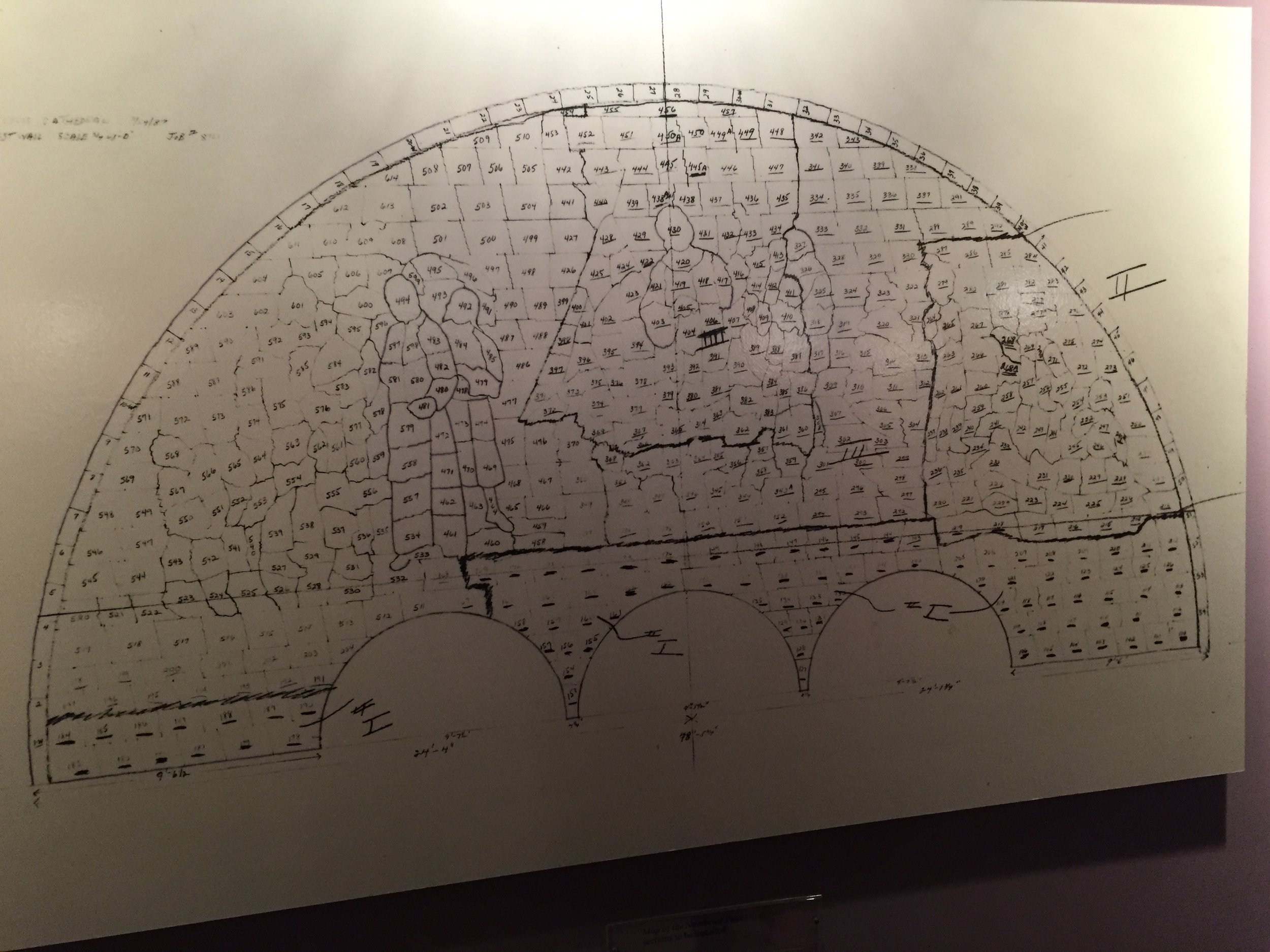The Cathedral Basilica of St. Louis is a very special church inside and out. There is so much that this church has to show to the public. That includes the massive mosaic collection, how it is both a Cathedral and a Basilica, and the museum underneath the church.
Cathedral Basilica of St. Louis. St. Louis, Mo. Photo by Kat Lane, 2017.
St. Louis has over 55 religious orders in the city, which has also been called the “Rome of the West.” The original plans were to build a Gothic church, but the diocese decided on a Byzantine church. Gothic churches are usually structures made of stone which have sharply pointed spires, ribbed vaults, and flying buttresses. On the other hand, Byzantine churches look a lot like Roman churches. They are much more symmetrical in general than Gothic style churches. The Cathedral Basilica of St. Louis (often called the “new Cathedral" to distinguish it from the older Basilica of St. Louis, King of France in downtown St. Louis) was built in 1914. It was opened by John J. Glennon, who became Cardinal Glennon soon after.
Museum
The museum that is under the Cathedral Basilica of St. Louis exists for a reason. One of the main reasons the museum was added to the church was because of the extra room that they had. Therefore, they decided to put a museum down there to show off to the public. Another more important reason is that the crypt is down there. Planners built the museum around the crypt, therefore they put up exhibits of historical significance and space. The crypt contains the remains of St. Louis’s Cardinals and Archbishops. The museum also shows how the mosaics that cover the interior of the cathedral were designed and applied. It also contains the original Kilgen organ console, the throne that was used during Pope John Paul II’s 1999 visit to St. Louis, and a historic collection of vestments and objects used in the many rites of the church. It is very significant that the Cathedral Basilica of St. Louis has a museum, because it can show off and teach all the history and important events that have occured in this church or in relation to it. Everyone who goes there to visit will come out with more knowledge about this church's history than what they went in with.
The cathedral basilica gets the title Cathedral because it houses a Cathedra. A Cathedra, or a “Bishop’s Throne,” is translated to a chair with armrests, but it is used as the seat of the bishop when he is in the church. Traditionally the cathedra was placed behind the high altar or in the apse. The apse is a semicircular recess covered with a hemispherical vault or semi-dome. During the middle ages its placement shifted to the wall of the apse.
Conopaeum. Cathedral Basilica of St. Louis. St. Louis, Mo. Photo by Kat Lane, 2017.
The title Basilica is given to some Roman Catholic church buildings and comes from the greek word for “royal house.” There are two types of Basilica, Major and Minor. Major Basilica can only exist inside the diocese of Rome. All other basilica are outside the diocese of Rome. The title of Basilica is denoted by a red and yellow umbrella, also called a conopaeum, and a bell, tintinnabulum.
Minor basilicas are traditionally named because of their antiquity, dignity, historical value, architectural and artistic worth, and/or significance as centers of worship. A basilica must “stand out as a center of active and pastoral liturgy.” Once that condition is deemed to be met, various documents explaining why the building deserves the title must be sent to the Congregation for Divine Worship and the Discipline of the Sacraments, where it is reviewed. If it passes then it gains the title, the conopaeum, and the tintinnabulum.
Mosaics
The Cathedral Basilica is known for their beautiful mosaics that make up the entire inside of the Church. The museum underneath the Cathedral contains displays that show how the mosaics are designed and applied. Long, detailed, creative work is put into the process of the creation of the mosaics. The Cathedral contains both Byzantine (colored glass tesserae) and Italian (colored marble tesserae) mosaics and the museum explains the difference in full detail.
Interior. Cathedral Basilica of St. Louis. St. Louis, Mo. Photo by Kat Lane, 2017.
Creation of the unique mosaics begins with an artist’s design. The subject of the design is chosen by the patron who has commissioned the mosaic work and the artist. The artist then creates a sketch of his or her conception of the chosen subject and gets it approved by the patron. After approval, the artist creates a large-scale watercolor version of the design which will become the template for the actual mosaicist who will then translate it into mosaic form.
The mosaicist must translate the final to-scale watercolor template she receives from the artist and trace the design on brown paper in reverse. The paper is then cut up into small sections small enough for the mosaicist to work at their work tables. The mosaicist then selects tesserae, small fragments of colored glass, that fit with the artist’s watercolor design to reproduce the template in full detail. The selected tesserae are then placed on the outline of the artist’s drawing on the brown paper. With a small anvil and chisel, the mosaicist must style the tesserae into the shapes needed to fit the artist’s design perfectly. Long hours and hard work are put into the designing of such small pieces that make up a more meaningful image in the end.
Once the tedious work of the mosaicist is finished, the end result is hundreds of fragments of the final mosaic pasted on the brown paper backing. Each piece is numbered and will be placed strategically on the wall to create the larger mosaic image. The mosaicist has a diagram that shows where each numbered piece will go on the wall, and from here it is like solving a giant puzzle. Two layers of foundation cement are applied to the wall and the mosaic sections counted on the brown paper are pressed into the cement and tapped into place with a wooden mallet. The paper is then removed and the final mosaic is revealed. This process is done for each section until the walls are complete with the whole image.
What is unique about the Cathedral Basilica is that it contains both Byzantine and Italian mosaics. All the mosaics in the Cathedral except the ones in the Blessed Virgin’s and All Saints’ Chapels, are Byzantine mosaics. The Byzantine mosaics are known for the small fragments of glass that have reflective quality. Tesserae of colored glass and of gold-leafed glass make up these fragments and really bring out the detail of the design. Italian mosaics on the other hand, are generally made up of colored marble tesserae rather than glass like the Byzantine style. The surface of these pieces are duller and does not have quite the reflective quality that the Byzantine mosaics are known for. These beautiful mosaics make up the entire inside of the Cathedral and is what makes the Cathedral Basilica so unique.
Researched and written by Joseph Doyle, Kyle Goldman, and Kat Lane
Additional Sources
Bradley, James E., and Richard A. Muller. 2016. Church history : an introduction to research methods and resources. Grand Rapids, Michigan : William B. Eerdmans Publishing Company, 2016.
Cathedral Plans Accepted. (1901, Jun 09). St.Louis Post - Dispatch (1879-1922) Retrieved from https://ezp.slu.edu/login?url=https://search.proquest.com/docview/579591171?accountid=8065
Lane, Kat A. Museum Photos. October 29, 2017. Cathedral Basilica Mosaic Museum, St. Louis.
Schild, Jim, and William Barnaby Faherty. 1995. House of God : the historic churches and places of worship of the St. Louis area. n.p.: Florissant, Mo. : Auto Review, c1995.
Walsh, John G., and Jack Zehrt. The Cathedral of Saint Louis. Saint Louis, MO: The Cathedral, 1964.
WorldSiteGuides. “Cathedral Basilica of St. Louis”. YouTube video, 5:12. Posted [January 2011]. https://www.youtube.com/watch?v=Tg4Uuoag3Gc.







